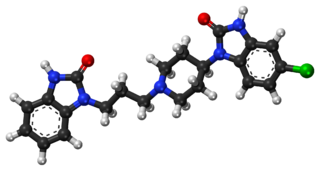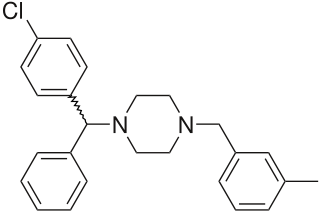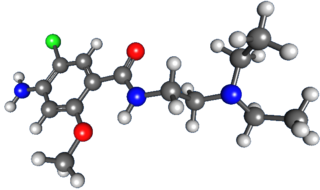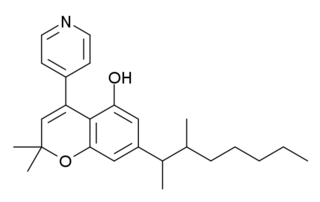 W
WThe 5-HT3 antagonists, informally known as "setrons", are a class of drugs that act as receptor antagonists at the 5-HT3 receptor, a subtype of serotonin receptor found in terminals of the vagus nerve and in certain areas of the brain. With the notable exceptions of alosetron and cilansetron, which are used in the treatment of irritable bowel syndrome, all 5-HT3 antagonists are antiemetics, used in the prevention and treatment of nausea and vomiting. They are particularly effective in controlling the nausea and vomiting produced by cancer chemotherapy and are considered the gold standard for this purpose.
 W
WAcepromazine, acetopromazine, or acetylpromazine is a phenothiazine derivative antipsychotic drug. It was used in humans during the 1950s as an antipsychotic, but is now almost exclusively used on animals as a sedative and antiemetic. Its closely related analogue, chlorpromazine, is still used as an antipsychotic in humans. Acepromazine is used primarily as a chemical restraint in hyperactive or fractious animals.
 W
WAlimemazine (INN), also known as trimeprazine,, commonly provided as a tartrate salt, is a phenothiazine derivative that is used as an antipruritic. It also acts as a sedative, hypnotic, and antiemetic for prevention of motion sickness. Although it is structurally related to drugs such as chlorpromazine, it is not used as an antipsychotic. In the Russian Federation, it is marketed under the brand name Teraligen for the treatment of anxiety disorders, organic mood disorders, sleep disturbances, personality disorders accompanied by asthenia and depression, somatoform autonomic dysfunction and various neuroses.
 W
WAlizapride is a dopamine antagonist with prokinetic and antiemetic effects used in the treatment of nausea and vomiting, including postoperative nausea and vomiting. It is structurally related to metoclopramide and other benzamides.
 W
WAmisulpride is an antiemetic and antipsychotic medication used at lower doses intravenously to prevent and treat postoperative nausea and vomiting; and at higher doses orally and intramuscularly to treat schizophrenia and acute psychotic episodes. It is sold under the brand names Barhemsys and Solian, Socian, Deniban and others. It is also used to treat dysthymia.
 W
WAprepitant, sold under the brand name Emend among others, is a medication used to prevent chemotherapy-induced nausea and vomiting (CINV) and to prevent postoperative nausea and vomiting. It may be used together with ondansetron and dexamethasone. It is taken by mouth.
 W
WAS-8112 is a synthetic compound that acts as a selective antagonist at the dopamine receptor subtypes D2 and D3, and the serotonin receptor 5-HT3. It has potent antiemetic effects in animal studies and has been investigated for potential medical use.
 W
WBatanopride (BMY-25,801) is an antiemetic drug of the benzamide class which acts as a selective 5-HT3 receptor antagonist. It was trialled to reduce nausea during cancer chemotherapy, but was never approved for medical use due to dose-limiting side effects including hypotension and long QT syndrome.
 W
WBenzquinamide is a discontinued antiemetic drug used in post-operative care. It was first synthesised by Pfizer in the 1960s.
 W
WBromopride (INN) is a dopamine antagonist with prokinetic properties widely used as an antiemetic, closely related to metoclopramide. It is not available in the United States.
 W
WCasopitant (INN, tentative trade names Rezonic (U.S.), Zunrisa (Europe)) is a neurokinin 1 receptor (NK1R) antagonist undergoing research for the treatment of chemotherapy-induced nausea and vomiting (CINV). It is currently under development by GlaxoSmithKline (GSK).
 W
WCerium(III) oxalate (cerous oxalate) is the inorganic cerium salt of oxalic acid. It is a white crystalline solid with the chemical formula of Ce2(C2O4)3. It could be obtained by the reaction of oxalic acid with cerium(III) chloride.
 W
WChlorpromazine (CPZ), marketed under the brand names Thorazine and Largactil among others, is an antipsychotic medication. It is primarily used to treat psychotic disorders such as schizophrenia. Other uses include the treatment of bipolar disorder, severe behavioral problems in children including those with attention deficit hyperactivity disorder, nausea and vomiting, anxiety before surgery, and hiccups that do not improve following other measures. It can be given by mouth, by injection into a muscle, or into a vein.
 W
WClebopride is a dopamine antagonist drug with antiemetic and prokinetic properties used to treat functional gastrointestinal disorders. Chemically, it is a substituted benzamide, closely related to metoclopramide.
 W
WCyclizine, sold under a number of brand names, is a medication used to treat and prevent nausea, vomiting and dizziness due to motion sickness or vertigo. It may also be used for nausea after general anaesthesia or that which developed from opioid use. It is taken by mouth, in the rectum, or injected into a vein.
 W
WDazopride (AHR-5531) is an antiemetic and gastroprokinetic agent of the benzamide class which was never marketed. It acts as a 5-HT3 receptor antagonist and 5-HT4 receptor agonist. In addition to its gastrointestinal effects, dazopride facilitates learning and memory in mice.
 W
WDimenhydrinate, marketed as Draminate, Dramamine and Gravol among others, is an over-the-counter drug used to treat motion sickness and nausea. Dimenhydrinate is a combination drug of diphenhydramine and 8-Chlorotheophylline.
 W
WDiphenhydramine is an antihistamine mainly used to treat allergies. It can also be used for insomnia, symptoms of the common cold, tremor in parkinsonism, and nausea. It is used by mouth, injection into a vein, injection into a muscle, or applied to the skin. Maximal effect is typically around two hours after a dose, and effects can last for up to seven hours.
 W
WDiphenidol is a muscarinic antagonist employed as an antiemetic and as an antivertigo agent. It is not marketed in the United States or Canada.
 W
WDolasetron (trade name Anzemet) is a serotonin 5-HT3 receptor antagonist used to treat nausea and vomiting following chemotherapy. Its main effect is to reduce the activity of the vagus nerve, which is a nerve that activates the vomiting center in the medulla oblongata. It does not have much antiemetic effect when symptoms are due to motion sickness. This drug does not have any effect on dopamine receptors or muscarinic receptors.
 W
WDomperidone, sold under the brand name Motilium among others, is a medication used as an antiemetic, gastric prokinetic agent, and galactagogue. It may be taken by mouth or rectally, and is available as a tablet, orally disintegrating tablets, suspension, and suppositories. The drug is used to relieve nausea and vomiting; to increase the transit of food through the stomach ; and to promote lactation by release of prolactin.
 W
WDoxylamine is a first-generation antihistamine used as a short-term sedative and hypnotic (sleep aid) or in combination formulations to provide night-time allergy and cold relief. It provides a calmative effect in preparations containing the analgesics paracetamol (acetaminophen) and codeine. It is prescribed in combination with vitamin B6 (pyridoxine) to prevent morning sickness in pregnant women. Its fetal safety rating is "A" (no evidence of risk).
 W
WThe International Nonproprietary Name Dronabinol, also known as Marinol and Syndros, is a trade name for a specific form of tetrahydrocannabinol, sold as an appetite stimulant, antiemetic, and sleep apnea reliever. It is approved by the FDA as safe and effective for HIV/AIDS-induced anorexia and chemotherapy-induced nausea and vomiting only.
 W
WDroperidol is an antidopaminergic drug used as an antiemetic and as an antipsychotic. Droperidol is also often used as a sedative in intensive-care treatment.
 W
WEzlopitant (INN, code name CJ-11,974) is an NK1 receptor antagonist. It has antiemetic and antinociceptive effects. Pfizer was developing ezlopitant for the treatment of irritable bowel syndrome but it appears to have been discontinued.
 W
WFluphenazine, sold under the brand names Prolixin among others, is an antipsychotic medication. It is used in the treatment of chronic psychoses such as schizophrenia, and appears to be about equal in effectiveness to low-potency antipsychotics like chlorpromazine. It is given by mouth, injection into a muscle, or just under the skin. There is also a long acting injectable version that may last for up to four weeks. Fluphenazine decanoate, the depot injection form of fluphenazine, should not be used by people with severe depression.
 W
W{{Drugbox | Verifiedfields = changed | Watchedfields = changed | verifiedrevid = 416448532 | IUPAC_name = [3-{[(2R,3S)-2-[(1R)-1-[3,5-bis(trifluoromethyl)phenyl] ethoxy]-3-(4-fluorophenyl)morpholin-4-yl]methyl}-5-oxo- 2H-1,2,4-triazol-1-yl]phosphonic acid | image = Fosaprepitant.svg | alt = Skeletal formula of fosaprepitant | width = 255 | image2 = Fosaprepitant-3D-spacefill.png | alt2 = Space-filling model of the fosaprepitant molecule | tradename = | Drugs.com = Multum Consumer Information | MedlinePlus = a604003 | licence_EU = yes | licence_US = Fosaprepitant | pregnancy_AU = | pregnancy_US = B | pregnancy_category = | legal_AU = | legal_CA = | legal_UK = POM | legal_US = Rx-only | routes_of_administration = Intravenous | bioavailability = n/a | protein_bound = >95% (aprepitant) | metabolism = To aprepitant | elimination_half-life = 9 to 13 hours (aprepitant) | excretion = | IUPHAR_ligand = 7623 | CAS_number_Ref = | CAS_number = 172673-20-0 | CAS_supplemental = 265121-04-8 (dimeglumine) | ATC_prefix = A04 | ATC_suffix = AD12 | PubChem = 219090 | DrugBank_Ref = | DrugBank = DB06717 | UNII_Ref = | UNII = 6L8OF9XRDC | KEGG_Ref = | KEGG = D06597 | ChEMBL_Ref = | ChEMBL = 1199324 | ChEBI_Ref = | ChEBI = 64321 | ChemSpiderID_Ref = | ChemSpiderID = 189912 | C=23 | H=22 | F=7 | N=4 | O=6 | P=1 | smiles = C[C@H](c1cc C F)O[C@@H]2[C@@H](N Cc3[nH]c n P O)c4ccc(cc4)F | StdInChI_Ref = | StdInChI = 1S/C23H22F7N4O6P/c1-12(14-8-15 10-16 23 30)40-20-19(13-2-4-17 5-3-13)33(6-7-39-20)11-18-31-21(35)34(32-18)41(36,37)38/h2-5,8-10,12,19-20H,6-7,11H2,1H3,(H,31,32,35)(H2,36,37,38)/t12-,19+,20-/m1/s1 | StdInChIKey_Ref = | StdInChIKey = BARDROPHSZEBKC-OITMNORJSA-N }}
 W
WGranisetron is a serotonin 5-HT3 receptor antagonist used as an antiemetic to treat nausea and vomiting following chemotherapy and radiotherapy. Its main effect is to reduce the activity of the vagus nerve, which is a nerve that activates the vomiting center in the medulla oblongata. It does not have much effect on vomiting due to motion sickness. This drug does not have any effect on dopamine receptors or muscarinic receptors.
 W
WHaloperidol, sold under the brand name Haldol among others, is a typical antipsychotic medication. Haloperidol is used in the treatment of schizophrenia, tics in Tourette syndrome, mania in bipolar disorder, nausea and vomiting, delirium, agitation, acute psychosis, and hallucinations in alcohol withdrawal. It may be used by mouth or injection into a muscle or a vein. Haloperidol typically works within 30 to 60 minutes. A long-acting formulation may be used as an injection every four weeks in people with schizophrenia or related illnesses, who either forget or refuse to take the medication by mouth.
 W
WHydroxyzine, sold under the brand names Atarax and others, is an antihistamine medication. It is used in the treatment of itchiness, anxiety, and nausea, including that due to motion sickness. It is used either by mouth or injection into a muscle.
 W
WLerisetron (code name F-0930-RS) is a drug which acts as an antagonist at the 5-HT3 receptor. It is a potent antiemetic and was in clinical trials for the treatment of nausea associated with cancer chemotherapy.
 W
WLevomepromazine, also known as methotrimeprazine, is a phenothiazine neuroleptic drug. Brand names include Nozinan, Levoprome, Detenler, Hirnamin, Levotomin and Neurocil. It is a low-potency antipsychotic with strong analgesic, hypnotic and antiemetic properties that are primarily used in palliative care.
 W
WLorazepam, sold under the brand name Ativan among others, is a benzodiazepine medication. It is used to treat anxiety disorders, trouble sleeping, active seizures including status epilepticus, alcohol withdrawal, and chemotherapy-induced nausea and vomiting. It is also used during surgery to interfere with memory formation and to sedate those who are being mechanically ventilated. While it can be used for severe agitation, midazolam is usually preferred. It is also used, along with other treatments, for acute coronary syndrome due to cocaine use. It can be given by mouth or as an injection into a muscle or vein. When given by injection onset of effects is between one and thirty minutes and effects last for up to a day.
 W
WMeclizine, sold under the brand names Bonine among others, is an antihistamine used to treat motion sickness and the feeling like the world is spinning (vertigo). It is taken by mouth. Effects generally begin in an hour and last for up to a day.
 W
WMedical cannabis, or medical marijuana (MMJ), is cannabis and cannabinoids that are prescribed by physicians for their patients. The use of cannabis as medicine has not been rigorously tested due to production and governmental restrictions, resulting in limited clinical research to define the safety and efficacy of using cannabis to treat diseases. Preliminary evidence suggests that cannabis can reduce nausea and vomiting during chemotherapy, improve appetite in people with HIV/AIDS, reduces chronic pain and muscle spasms and treats severe forms of epilepsy.
 W
WMegestrol acetate (MGA), sold under the brand name Megace among others, is a progestin medication which is used mainly as an appetite stimulant to treat wasting syndromes such as cachexia. It is also used to treat breast cancer and endometrial cancer, and has been used in birth control. MGA is generally formulated alone, although it has been combined with estrogens in birth control formulations. It is usually taken by mouth.
 W
WMetoclopramide is a medication used mostly for stomach and esophageal problems. It is commonly used to treat and prevent nausea and vomiting, to help with emptying of the stomach in people with delayed stomach emptying, and to help with gastroesophageal reflux disease. It is also used to treat migraine headaches.
 W
WMetopimazine (INN) is a phenothiazine antiemetic.
 W
WMirtazapine, sold under the brand name Remeron among others, is an antidepressant of the atypical antidepressants class primarily used to treat depression. Its full effect may take more than four weeks to occur, with some benefit possibly as early as one to two weeks. Often it is used in depression complicated by anxiety or trouble sleeping. It is taken by mouth.
 W
WNetupitant is an antiemetic drug. In the United States, the combination drug netupitant/palonosetron is approved by the Food and Drug Administration for prevention of acute and delayed chemotherapy-induced nausea and vomiting, including highly emetogenic chemotherapy such as with cisplatin. In Europe, it is approved by the European Medicines Agency (EMA) for the same indication.
 W
WNonabine (BRL-4664) is an experimental drug which is a synthetic THC analog. It was studied in the 1980s for the prevention of nausea and vomiting associated with cancer chemotherapy but was never marketed. It has strong antiemetic effects equivalent to those of chlorpromazine, and also produces some mild sedative effects, along with dry mouth and EEG changes typical of cannabinoid agonists, but with minimal changes in mood or perception, suggesting the abuse potential is likely to be low.
 W
WOndansetron, sold under the brand name Zofran among others, is a medication used to prevent nausea and vomiting caused by cancer chemotherapy, radiation therapy, or surgery. It is also effective for treating gastroenteritis. It is ineffective for treating vomiting caused by motion sickness. It can be given by mouth or by injection into a muscle or into a vein.
 W
WPeppermint is a hybrid mint, a cross between watermint and spearmint. Indigenous to Europe and the Middle East, the plant is now widely spread and cultivated in many regions of the world. It is occasionally found in the wild with its parent species.
 W
WPipamazine is a drug of the phenothiazine class formerly used as an antiemetic. It is chemically related to chlorpromazine, but has negligible antipsychotic activity and produces few extrapyramidal side effects.
 W
WProchlorperazine, sold under the brand name Compazine among others, is a medication used to treat nausea, schizophrenia, migraines, and anxiety. It is a less preferred medication for anxiety. It may be taken by mouth, rectally, injection into a vein, or injection into a muscle.
 W
WPromethazine is a first-generation antihistamine. It is used to treat allergies, trouble sleeping, and nausea. It may help with some symptoms associated with the common cold. It may also be used for sedating people who are agitated or anxious. It is available by mouth as a syrup, as a rectal suppository, or by injection into a muscle.
 W
WProthipendyl, also known as azaphenothiazine or phrenotropin, is an anxiolytic, antiemetic, and antihistamine of the azaphenothiazine group which is marketed in Europe and is used to treat anxiety and agitation in psychotic syndromes. It differs from promazine only by the replacement of one carbon atom with a nitrogen atom in the tricyclic ring system. Prothipendyl is said to not possess antipsychotic effects, and in accordance, appears to be a weaker dopamine receptor antagonist than other phenothiazines.
 W
WRamosetron (INN) is a serotonin 5-HT3 receptor antagonist for the treatment of nausea and vomiting. Ramosetron is also indicated for a treatment of "diarrhea-predominant irritable bowel syndrome in male and women". In India it is marketed under the brand name of Ibset.
 W
WRolapitant (INN, trade name Varubi və-ROO-bee in the US and Varuby in the European Union) is a drug originally developed by Schering-Plough and licensed for clinical development by Tesaro, which acts as a selective NK1 receptor antagonist (antagonist for the NK1 receptor). It has been approved as a medication for the treatment of chemotherapy-induced nausea and vomiting (CINV) after clinical trials showed it to have similar or improved efficacy and some improvement in safety over existing drugs for this application.
 W
WTetrahydrocannabinol (THC) is one of at least 113 cannabinoids identified in cannabis. THC is the principal psychoactive constituent of cannabis. Although the chemical formula for THC (C21H30O2) describes multiple isomers, the term THC usually refers to the Delta-9-THC isomer with chemical name (−)-trans-Δ⁹-tetrahydrocannabinol. Like most pharmacologically active secondary metabolites of plants, THC is a lipid found in cannabis, assumed to be involved in the plant's self-defense, putatively against insect predation, ultraviolet light, and environmental stress.
 W
WThiethylperazine (Torecan) is an antiemetic of the phenothiazine class. Though it was never licensed or used as an antipsychotic, it may have such effects.
 W
WTrimethobenzamide is an antiemetic used to prevent nausea and vomiting.
 W
WTropisetron is a serotonin 5-HT3 receptor antagonist used mainly as an antiemetic to treat nausea and vomiting following chemotherapy, although it has been used experimentally as an analgesic in cases of fibromyalgia.
 W
WVofopitant (GR205171) is a drug which acts as an NK1 receptor antagonist. It has antiemetic effects as with other NK1 antagonists, and also shows anxiolytic actions in animals. It was studied for applications such as the treatment of social phobia and post-traumatic stress disorder, but did not prove sufficiently effective to be marketed.